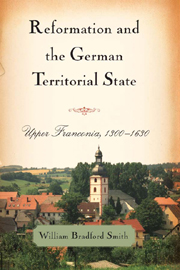Book contents
- Frontmatter
- Contents
- List of Illustrations
- List of Abbreviations
- Acknowledgments
- Introduction
- Chapter 1 Territory and Community
- Chapter 2 Rebellion, Representation, and Reform
- Chapter 3 “Lord in Our Own House”
- Chapter 4 Reformation and Revolution
- Chapter 5 The Limits of Obedience
- Chapter 6 A Plague of Preachers
- Chapter 7 Orthodoxy and Order
- Chapter 8 The Christian Commune
- Chapter 9 Cuius Regio?
- Chapter 10 The Stool of Wickedness
- Conclusion
- Notes
- Bibliography
- Index
Introduction
Published online by Cambridge University Press: 12 September 2012
- Frontmatter
- Contents
- List of Illustrations
- List of Abbreviations
- Acknowledgments
- Introduction
- Chapter 1 Territory and Community
- Chapter 2 Rebellion, Representation, and Reform
- Chapter 3 “Lord in Our Own House”
- Chapter 4 Reformation and Revolution
- Chapter 5 The Limits of Obedience
- Chapter 6 A Plague of Preachers
- Chapter 7 Orthodoxy and Order
- Chapter 8 The Christian Commune
- Chapter 9 Cuius Regio?
- Chapter 10 The Stool of Wickedness
- Conclusion
- Notes
- Bibliography
- Index
Summary
Religious reform and the rise of the territorial state mark the two distinguishing characteristics of German history in the transition between the Middle Ages and the modern world. But just as 1517 no longer stands as the beginning of the Reformation, neither does 1555 mark the beginning of territorial state building. The twin processes of religious reform and territorial formation have a much longer history, beginning in the later Middle Ages and continuing through the early modern period. The essential relationship between the rise of the territorial state and the reform movements of the fourteenth through the early seventeenth centuries provides the primary focus of this study. Our investigation centers on the diocese of Bamberg in upper Franconia. During the Reformation, the diocese was split in half: the parishes in the domains of the Franconian Hohenzollerns became Lutheran, while those under the secular jurisdiction of the bishops of Bamberg remained Catholic. The history of the region provides an excellent opportunity to compare the origins and course of Catholic and Protestant reform in the late Middle Ages and the early modern period. In particular, what this book seeks to understand is the role that religious reform played in the formation of the territorial state. Although much of recent scholarship has explored the impact of the sixteenth-century reformations on the development of the modern state, our concern here is rather with the ways in which those reform movements were themselves inseparable from the historical circumstances that gave rise to the territorial state.
- Type
- Chapter
- Information
- Reformation and the German Territorial StateUpper Franconia, 1300–1630, pp. 1 - 8Publisher: Boydell & BrewerPrint publication year: 2008



